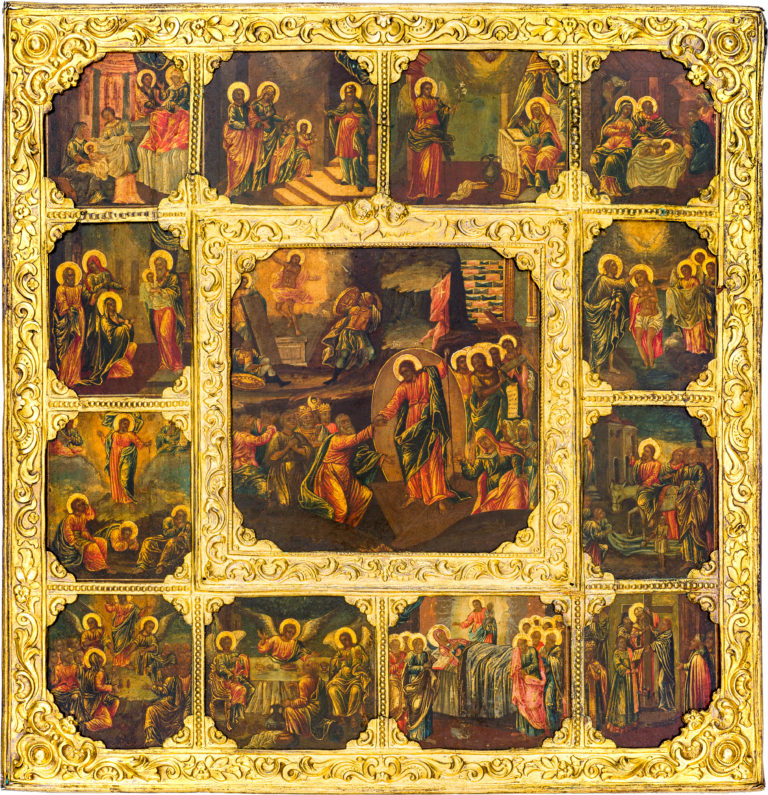The Resurrection—the Descent into Hell, with Church Feasts in 12 Border Scenes
Antique Russian icon: second half of the 18th century. Central Russia. Oklad cover: 1852. Moscow. V.S. Semenov’s workshop.
Size: 39 х 38 х 3 cm
Wood, underlying layer of canvas is not visible, gesso, tempera. Oklad cover: silver, embossing, engraving, gilding.
Brands on the Oklad cover: Moscow coat-of-arms (around the middle of the 19th century); silver hallmark “84;” “М·Ч / 1852” – the brand of the assayer Michael Pavlovich Churmazov (1841–1852); “В·С” in the oval shield – the official brand of the Vasiliy Sergeevich Semenov’s silversmith workshop.
The author’s paintwork is in an overall good state, currently under the slightly darkened varnish (olifa) layer. Small fragmentations are seen on the metal oklad cover of the religious icon.
Contact us

The Resurrection—the Descent into Hell, with Church Feasts in 12 Border Scenes
Diagram of the border scenes:
Diagram of the border scenes:
- The Nativity of the Mother of God;
- The Entrance of the Mother of God into the Temple;
- The Annunciation;
- The Nativity of Christ (The Adoration of the Magi);
- Candlemas (The Meeting of Christ in the Temple);
- The Theophany (The Baptism of Christ);
- The Transfiguration;
- The Entrance into Jerusalem;
- The Ascension;
- The Old Testament Trinity;
- The Dormition of the Mother of God;
- The Elevation of the Holy Cross.
The complex iconography of the Resurrection – the Descent into Hell, which was built on two compositional centers, was developed in the middle of the 17th century and became increasingly popular in the following two centuries. In the religious icon paintings of this type, artists sometimes disregarded the strict compositional principle, moving one of the two central scenes to the side and increasing the other in size. In the given antique Russian icon, the accent is placed on the Harrowing of Hades, while the “Rising from the Tomb” is moved into the upper left corner. The iconography clearly attests to the artist’s dependence on Western European samples – the “Rising from the Tomb” scene exactly replicates the compositional scheme found in the Piscator Bible, where Christ is shown rising over the tomb, in floating robes, surrounded by guards fleeing in amazement. Another western trait visible in this hand-painted icon is the banner in Christ’s hand (in the Descent into Hell scene), which can be seen as the “victory standard.” The colorful rock-face stoned wall of the New Jerusalem is clearly reminiscent of similar depictions found in the Italian religious icon art pieces.
The given antique Russian icon clearly yearns to Baroque art – with its shapes, intense color scheme, floating vestments, expressive, flying draperies, and the energetic poses of the heavily built figures. The religious icon paintings are surrounded by extravagant cartouche frames – gold with black graphic work – imitating the gilded woodcarving that filled the interior of churches in the 18th century. The elegance and beauty of the miniature painting enforce the festive, pompous spirit of the given religious icon. The Baroque style was incredibly popular among various Russian social classes, where it held out until the 19th century despite the seeming domination of Classicism. The given antique Russian icon was painted in the second half of the 18th century when Baroque began to lose its primary position in art. As to the location – this piece probably comes from Central Russia and is closely linked to the Moscow religious icon art tradition, which is attested to by the simplified and draft-like painting manner.
The precious, extravagant quality of the hand-painted icon is enforced by the shining oklad cover that was commissioned several decades later – in 1852, at V.S. Semenov’s silversmith, engraving, and embossing workshop. Semenov’s workshop was known since 1852. It was located on Moscow’s Kaluzhskaya Street, in Semenov’s own house. The workshop was well-known for its silverwork decorated with niello. It reached the peak of fame in the 1870s. From the end of the 19th century, the business was successfully inherited and led on by Semenov’s daughter – Maria Vasilieva. The given oklad cover is among the first commissions of this renowned workshop that at that time had barely opened its doors. It is executed in the Second Baroque style and consists of recognizable natural motifs: lavish leaves, flowers, and rocailles. However, the symmetry and absence of accents in the embossing strip the oklad of the Baroque emotionality that could be found in works of religious icon art of the previous century.